Wiley 978-0-471-78544-6 User manual
- Category
- Software manuals
- Type
- User manual
This manual is also suitable for

1
Introduction to Ajax
on ASP.NET
Over the years, we developers have seen many changes in terms of how development occurs.
We have gone from terminal-based programming to PC-based programming to Windows-based
programming to the web. Now we are on the verge of another programming revolution. This pro-
gramming revolution will bring more interactive user interfaces to Web applications. This program-
ming revolution is brought to developers courtesy of a set of technologies that are generally known
as Ajax (Asynchronous JavaScript And XML). No longer will users see the annoying flash with the
click of a button to submit data. No longer will users lose the context where they are located and
be thrown back to the top of a page. With Ajax, developers can build applications that step out of
the traditional postback model of the web, provide an improved user interface to users, and allow
developers to develop applications that are much more user-friendly.
In this chapter, you are going to take a look at:
❑ ASP.NET development and how it led to Ajax
❑ What Ajax is and a high-level overview of some of its base technologies
❑ The advantages of Ajax
❑ Some things that it might not make sense to do with Ajax
Development Trends
If you have been developing for a while, like us old guys, you have gone through several iterations
of development. Development has gone from terminals connected to mainframes and minicom-
puters to personal computers and then to client-server development. Client-server development
allowed for the minimization of back-end resources, network resources, and the front-end PC by
sending only the necessary data between back end and front end. Intelligent client-server develop-
ment allowed for building applications that were responsive to the user and made efficient use of
network and back-end resources. As the web development methodology took off in the late 1990s,
we unfortunately returned to terminal-style development. In this methodology, any major operation
04_78544X ch01.qxp 7/18/06 3:12 PM Page 1
COPYRIGHTED MATERIAL

between the client and server requires that all data be sent in what is called a round trip. With a round
trip, all data from the form is sent from the client to the web server. The web server processes data, and
then sends it back to the client. The result of a round trip is that lots of data is sent back and forth
between the client and server. For example, form data, viewstate, and images may be sent back and forth
without the need to be sent back and forth. Figure 1-1 shows how only a web browser is required at the
client and how communications work with the web server being an intermediary between the client and
any resources.
Figure 1-1
ASP.NET Development
ASP.NET is a set of web development technologies produced by Microsoft that is used to build dynamic
web sites, web applications, and XML-based web applications. ASP.NET is a part of the .NET framework
and allows developers to build applications in multiple languages, such as Visual Basic .NET, Jscript,
and C#.
Design Methodology
ASP.NET attempts to make the web development methodology like the graphical user interface (GUI)
development methodology by allowing developers to build pages made up of controls similar to a GUI.
A server control in ASP.NET functions similarly to GUI controls in other environments. Buttons, textboxes,
labels, and datagrids have properties that can be modified and expose events that may be processed.
The ASP.NET server controls know how to display their content in an HTML page just like GUI-based
user controls know how to display themselves in their GUI environment. An added benefit of ASP.NET
is that the properties and methods of the web server controls are similar, and in some cases the same as,
those of comparable controls in the Windows GUI/Winforms environment.
Problems ASP.NET Solves
Microsoft has released various web application development methodologies over the past 10 years.
Why do developers need ASP.NET? What problems does ASP.NET solve that the previous development
methodologies did not solve?
Web server along with various
databases and other resources.
Web browser Client
Full page
including form
elements,
viewstate,
images, and
such.
HTTP postback
with all form
elements,
viewstate, and
associated
data.
2
Chapter 1
04_78544X ch01.qxp 7/18/06 3:12 PM Page 2

Microsoft’s first popular web development technology was the Internet Database Connector (IDC).
The IDC methodology provided only database access; it did not provide access to any other resource
programmatically. There was no way to programmatically send email or do other nondatabase operations.
Another issue was that it seemed to be somewhat different from the traditional programming languages
that most developers were used to (Visual Basic and C++ being two popular ones). Along with this prob-
lem was the fact that the development experience was not very attractive within Microsoft FrontPage.
Along with the development experience, IDC had no debugging experience worth mentioning. Overall,
IDC was nothing more than a stopgap measure to get to an improved environment.
The next web development methodology from Microsoft was Active Server Pages (ASP). ASP was
a scripting environment that allowed developers to work with a Visual Basic like or JavaScript type
environment. Unfortunately, this type of environment came with several problems:
❑ Prevalence of spaghetti code —ASP code does not provide a structured development environ-
ment, often contributing to the creation of twisted and tangled “spaghetti code.” ASP code is
literally a file with some basic configuration information at the top of every page. Each page
is executed from the top of the page to the bottom of the page. While it is possible to use
Component Object Model (COM) objects to eliminate some of the spaghetti code, this intro-
duces more complexity in the form of another development tool.
❑ Lack of code separation — The code tends to be intermixed with display code. Intermixing the
code and the display logic requires that the tools that developers and designers use work well
together. This was often not the case. For example, it was well known that various visual devel-
opment tools could take a properly running ASP page, rearrange some of the code, and render
the ASP page broken.
❑ Lack of code reusability — There is very little ability to reuse code within the ASP environment.
❑ Lack of debugging support — Debugging an ASP application typically involves the use of
Response.Write. This is in sharp contrast to an integrated development environment (IDE)
developed within a GUI environment.
❑ Problems of COM — ASP is based on the Component Object Model and suffers from many of
the problems associated with COM. There were two major problems with COM.
❑ The first was that updating COM objects tended to overwrite one object with the new
one. This could be problematic if a programming method call changed or any other new
behavior was introduced.
❑ The second major problem with COM was that it was a binary standard. This binary
standard was based on a 32-bit programming model. As a result, COM objects would
not scale up to run natively within an environment that was an Intel-based 32-bit envi-
ronment. While this might not have been a big deal in the early to middle 1990s when
COM was designed and built, by the early 2000s and the introduction of inexpensive
64-bit systems, this was seen as a possible bottleneck.
❑ Problems with being interpreted — ASP is interpreted. Each time an ASP file is loaded, the ASP
environment parses the ASP file, compiles the code, and then executes the file. This process is
repeated on each call to an ASP file. The result is wasted processing on the server.
❑ Presence of the statemachine — ASP applications typically have a statemachine (in software
code, a statemachine is a section of code that depends on both its direct inputs and inputs made
during previous calls) at the top of every ASP page that processes the state of the user and then
displays code. Given that most client-side applications are built based on events, which is a sim-
ilar concept to a statemachine, this is an unfamiliar way to develop for developers not well
versed in ASP.
3
Introduction to Ajax on ASP.NET
04_78544X ch01.qxp 7/18/06 3:12 PM Page 3

Upon discovering these problems, Microsoft developed ASP.NET. ASP.NET greatly simplifies the web
development methodology.
❑ Developers no longer need to worry about processing state. With ASP.NET, actions are per-
formed within a series of events that provide statemachine-like functionality.
❑ With the use of code-behind/beside model, code is separated from display. By separating code
and display files, there is less of a chance of designer and developer tools interfering with each
other.
❑ A single development tool may be used for building the application and business logic. Having
a single integrated development suite allows developers to more easily interact with the appli-
cation logic. This results in more code reuse and fewer errors.
❑ With the Visual Studio .NET IDE, ASP.NET supports many methods to debug and track a run-
ning ASP.NET.
❑ Because ASP.NET is based on the common language runtime (CLR) and .NET, ASP.NET does
not suffer from the problems of COM. The .NET framework allows for multiple versions of
components to be on a system without interacting with each other.
❑ ASP.NET is compiled. The first time that a file is loaded, it is compiled and then processed. The
compiled file is then saved into a temporary directory. Subsequent calls to the ASP.NET file are
processed from the compiled file. The execution of the compiled file on requests is faster than
the interpreted environment of Classic ASP.
All in all, ASP.NET is a dramatic improvement over ASP. It has become widely accepted in the develop-
ment community.
So, What’s the Problem?
Based on what you have just read regarding ASP.NET, it may sound really good to you. You may be ask-
ing yourself, “Why is there a need for something else? What’s the problem?”
The truth is ASP.NET has several issues that need to be addressed:
❑ Round trips — The server events in ASP.NET require round trips to the server to process these
events. These round trips result in all form elements being sent between client and server as
well as images and other data files being sent back to the client from the server. While some web
browsers will cache images, there can still be significant data transfer.
❑ Speed/network data transfer — Because of the
VIEWSTATE hidden form element, the amount of
data that is transferred during a postback is relatively large. The more data and controls on the
page, the larger the
VIEWSTATE will be and the more data that must be processed on the server
and transmitted back to the client.
❑ Waiting on the result — When a user clicks on a button or some other visual element that posts
data back to the server, the user must wait on a full round trip to complete. This takes time
when the processing is done on the server and all of the data, including images and viewstate,
are returned to the client. During that time, even if the user attempts to do something with the
user interface, that action is not actually processed on the client.
4
Chapter 1
04_78544X ch01.qxp 7/18/06 3:12 PM Page 4

❑ User context — Unless an application is able to properly use the SMARTNAVIGATION feature of
ASP.NET, the user is redirected to the top of a page by default on a postback. Although there are
ways around this issue, this is the default behavior.
❑ Processing — The number of server round trips, the amount of data that is transferred, and the
VIEWSTATE element’s size result in processing on the server that is not really necessary (Fig. 1-2).
Figure 1-2
Improving the User Experience
Based on these issues, several options present themselves as available for improving the user experience:
❑ Java — Java applets are cross-platform applications. While being used as a cross-platform mech-
anism to display data and improve the user experience, Java development on the client has not
been accepted with open arms into the development community and is primarily used for user
interface gee-whiz features as opposed to improving the experience of the user application.
(As a side note, Java has been widely accepted for building server-side applications.)
❑ XML-based languages — XML User Interface Language (XUL) and Extensible Application
Markup Language (XAML) are two of several languages that can provide an improved user
experience. The problem with XUL is that it has been used only in the Mozilla/Firefox line of
browsers. XAML is not currently available as a released product. When it is, it will have the
problem of being considered a Microsoft-only technology in spite of discussion items like
XAML-lite, which has been stated as cross-platform.
❑ Flash — Although Flash has been used and there are cross-platform versions, the product has
been used only in the area of graphic UI needs and has not been accepted by the development
community as a whole for building line-of-business applications.
❑ Ajax — Ajax is a set of client technologies that provides for asynchronous communication
between the user interface and the web server along with fairly easy integration with existing
technologies.
Given the amount of recent discussion among developers regarding Ajax, it appears that Ajax has the
greatest chance among these technologies of gaining market acceptance.
Server Response
Server Response
User Action
User Action
User Action
5
Introduction to Ajax on ASP.NET
04_78544X ch01.qxp 7/18/06 3:12 PM Page 5

What Is Ajax?
So into this development environment comes a set of technologies that are collectively referred to as
Ajax. If you are an “old guy” developer like us, then Ajax represents a similar concept to the client-
server development we mentioned earlier in the chapter. With client-server development, the amount of
data transferred is minimized over a terminal application by transferring only the necessary data back
and forth. Similarly, with Ajax, only the necessary data is transferred back and forth between the client
and the web server. This minimizes the network utilization and processing on the client. Figure 1-3
shows that typically Ajax operates with the assistance of some type of proxy.
Figure 1-3
Advantages of Ajax
The advantages of Ajax over classical web based applications are:
❑ Asynchronous — Ajax allows for the ability to make asynchronous calls to a web server. This
allows the client browser to avoid waiting for all data to arrive before allowing the user to act
once more.
❑ Minimal data transfer — By not performing a full postback and sending all form data to the
server, the network utilization is minimized and quicker operations occur. In sites and locations
with restricted pipes for data transfer, this can greatly improve network performance.
❑ Limited processing on the server — With the fact that only the necessary data is sent to the
server, the server is not required to process all form elements. By sending only the necessary
data, there is limited processing on the server. There is no need to process all form elements,
process the viewstate, send images back to the client, and no need to send a full page back to
the client.
Web server and associated backend
services, such as web services.
Web browser client
Data back in
an XML format
or other format
without the
weight of a
postback.
XML data
format in
over HTTP
with no
postback.
Ajax proxy services
6
Chapter 1
04_78544X ch01.qxp 7/18/06 3:12 PM Page 6

❑ Responsiveness — Because Ajax applications are asynchronous on the client, they are perceived
to be very responsive.
❑ Context — With a full postback, the user may lose the context of where they are. The user
may be at the bottom of a page, hit the Submit button, and be redirected back to the top of
the page. With Ajax there is no full postback. Clicking the Submit button in an application that
uses Ajax will allow the user to maintain their location. The user state is maintained, and the
user is no longer required to scroll down to the location that he or she was at before clicking
Submit.
Figure 1-4 shows how the user interface can still operate while using Ajax. The UI is not locked during
the server processing.
Figure 1-4
History of Ajax
For all of its perceived newness and sexiness, the technologies that make up Ajax are really not new.
The ability to communicate back to the server through a hidden frame without posting the main page
back to the server has been around for a long time. Communication between client and server has been
available — back to the release of Internet Explorer’s ability to script ActiveX controls on the client browser
and to the MSXML component, both of which date back into the late 1990s. Personally, I saw the first for-
mal usage of client script and MSXML in 2003. The problem with the technology at that time was the
need to manually create the necessary client-side JavaScript. In 2003, there was too much code overall
that had to be written and too much custom code that had to be written to get this to work. It has been
only in the second half of 2005 that client-side libraries and server-side support for ASP.NET have
started to make their presence felt and been used significantly.
The mainstream development community has only recently started using the technique. The release of
Google’s Suggest and Maps are what really opened the eyes of the users to the development technolo-
gies. These applications sent a shockwave through the development community.
Server Response
Server Response
User Action
User Action
User Action
7
Introduction to Ajax on ASP.NET
04_78544X ch01.qxp 7/18/06 3:12 PM Page 7

Technologies That Make Up Ajax
Ajax is a general umbrella term. As mentioned earlier, Ajax itself stands for Asynchronous JavaScript
And XML. The term Ajax was actually coined by Jesse James Garret of Adaptive Path in an essay that
was published in February 2005 (
www.adaptivepath.com/publications/essays/archives/
000385.php
) and was quickly accepted by the development community.
Based on this general umbrella term, take a look at the specific items that make up Ajax:
❑ XmlHttpRequest —
XmlHttpRequest allows the browser to communicate to a back-end server.
This object allows the browser to talk to the server without requiring a postback of the entire
web page. With Internet Explorer, this capability is provided by the MSXML ActiveX compo-
nent. With the Mozilla Firefox and other web browsers, this capability is provided by an object
literally called
XmlHttpRequest. The XmlHttpRequest object is modeled after the MSXML
component. The client-side JavaScript libraries hide the differences between the various browser
environments. Sometimes these communications are done through a hidden
FRAME or IFRAME.
❑ JavaScript — JavaScript provides the capabilities to communicate with the back-end server.
The JavaScript must be version 1.5 or later. Although JavaScript is not specifically required, it
is needed from the standpoint that JavaScript is the only client-side scripting environment sup-
ported across the major modern web browsers. There are other client script languages; however,
these are not supported across all browsers.
❑ DHTML/DOM support — The browser must support the ability to dynamically update form
elements, and the ability to do this in a standard way comes through the support for the
Document Object Model (DOM). By supporting the DOM, it becomes easy for developers to
write a single piece of code that targets multiple browsers.
❑ Data transport with XML or JSON— Using XML allows for the ability to communicate with
the web server in a standard mechanism. There are situations where the JavaScript Object
Notation (JSON) is used as the communication notation instead of straight XML.
Running Ajax Applications
Unfortunately, not all web browsers ever produced will support Ajax. To run Ajax, a web browser must:
❑ Be relatively modern. Ajax style applications are not available in all versions of all web browsers.
Whereas Internet Explorer version 6, Firefox version 1.5, and Opera 8.5 provide support for
these applications, older versions may be problematic because of their support for different
versions of the other requirements.
❑ Support DOM.
❑ Utilize JavaScript.
❑ Support Extensible Markup Language (XML) and Extensible Style Language Transformation
(XSLT).
❑ Possibly have ActiveX enabled on the client. If you are using the Internet Explorer browser
while running on Windows, you may have problems if ActiveX is not enabled.
8
Chapter 1
04_78544X ch01.qxp 7/18/06 3:12 PM Page 8

Who’s Using Ajax?
Great, now that you have seen that there is this technology called Ajax, are you alone in not having seen
or talked about this before? Absolutely not! Ajax has just recently taken off in the second half of 2005
from a mindshare standpoint. As discussions have gone on with counterparts in the development com-
munity, many developers are just now looking to what Ajax can do for their applications and ultimately
their customers. So, just who is using Ajax publicly?
❑ Google Suggest — Google Suggest features a dynamic drop-down list box that provides possi-
ble items to search on along with the approximate number of search results.
❑ Google Maps — The ability to grab a map and zoom around without requiring a postback is
just amazing. This app/service took the development world by storm when it came out.
❑ Google GMail — Google GMail is a web-based email system available through Google.
❑ Microsoft Hotmail Kahuna update — At the time of this writing, the Hotmail upgrade that
is referred to as Kahuna is in beta test. As a beta user of the application, I can testify to the
improved user interface and responsiveness that this application provides.
❑ Live.com — The local.live.com service from Microsoft is actively using the Atlas framework, as
is nearly the entire Live.com service.
❑ Easy Search component — The ASP.NET Easy Search Component provides support for search-
ing a single web site similar to the Google Suggest service available through Google.
❑ Other component vendors — Component vendors such as ComponentArt, Dart, and others are
providing controls that provide a rich user experience without forcing a full postback.
In addition to third-party interest, the amount of developer interest is tremendous. For example, one
only has to put the word Ajax into a blog title to receive an increase in the number of web views. Given
the amount of third-party support and the interest of developers, it is only a matter of time before every-
one is using it.
Problems Ajax Won’t Solve
Ajax is a great technology with a lot of help for typical application problems and a lot of general
promise. It will help in areas like network load and user context by sending only the necessary data,
creating less network traffic when processing a command. The user is not redirected to the top of a page
when a command is sent the server. The problem is that to successfully run Ajax, a user needs to have
the transport mechanism and JavaScript support mentioned previously. That sounds like something that
any modern browser has, so what’s the problem? Well, the problem is that many mobile browsers have
support for neither. With many of Ajax solutions, you have limited or no downlevel support, so if you
must support a mobile system, you may be limited to writing multiple versions of your application
because Ajax may not be the right technology to include.
9
Introduction to Ajax on ASP.NET
04_78544X ch01.qxp 7/18/06 3:12 PM Page 9

Summary
Ajax provides developers a foundation to build web-based applications that provide an improved user
experience. In this introductory chapter, you have looked at:
❑ Development from a historical perspective
❑ Web development methodologies
❑ Some of the features that Ajax provides, such as improved user responsiveness and decreased
load on the web server
❑ Multiple technologies that can improve the user experience
❑ Ajax, the problems that it solves, and who is using it
In the next chapter, you are going to examine Dynamic HTML (DHTML). Additional chapters will look
at the other technologies that make up Ajax. After that you will examine the Ajax.NET library, Microsoft
Atlas, and finally tips and tricks on debugging client-side applications.
10
Chapter 1
04_78544X ch01.qxp 7/18/06 3:12 PM Page 10
-
 1
1
-
 2
2
-
 3
3
-
 4
4
-
 5
5
-
 6
6
-
 7
7
-
 8
8
-
 9
9
-
 10
10
Wiley 978-0-471-78544-6 User manual
- Category
- Software manuals
- Type
- User manual
- This manual is also suitable for
Ask a question and I''ll find the answer in the document
Finding information in a document is now easier with AI
Related papers
-
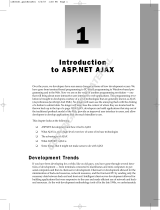 Wiley 978-0-470-11283-0 Datasheet
Wiley 978-0-470-11283-0 Datasheet
-
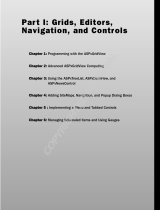 Wiley 978-0-470-50083-5 User manual
Wiley 978-0-470-50083-5 User manual
-
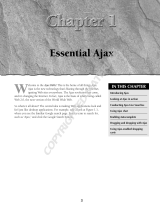 Wiley 978-0-470-10263-3 Datasheet
Wiley 978-0-470-10263-3 Datasheet
-
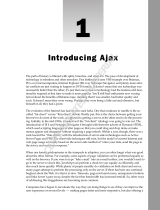 Wiley 978-0-470-10675-4 Datasheet
Wiley 978-0-470-10675-4 Datasheet
-
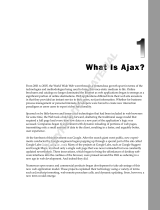 Wiley 978-0-470-10949-6 Datasheet
Wiley 978-0-470-10949-6 Datasheet
-
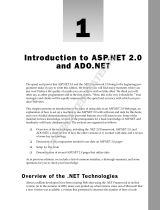 Wiley Beginning ASP.NET 2.0 and Databases User manual
Wiley Beginning ASP.NET 2.0 and Databases User manual
-
 Wiley 978-0-470-42138-3 Datasheet
Wiley 978-0-470-42138-3 Datasheet
-
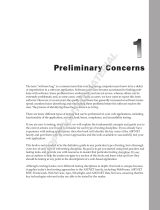 Wiley 978-0-470-49664-0 Datasheet
Wiley 978-0-470-49664-0 Datasheet
-
 Wiley 978-0-7645-7847-2 Datasheet
Wiley 978-0-7645-7847-2 Datasheet
-
 Wiley 978-0-470-19137-8 Datasheet
Wiley 978-0-470-19137-8 Datasheet
Other documents
-
Electrolux AJM68FD1 Datasheet
-
Adobe 38039255 Datasheet
-
Microsoft 124-00895 Datasheet
-
Adobe DREAMWEAVER CS3 User manual
-
Adobe ColdFusion 11.0 User guide
-
Adobe ColdFusion 10.0 User guide
-
National Instruments 373392C-01 User manual
-
Adobe 38043740 - ColdFusion Standard - Mac User manual
-
MACROMEDIA DREAMWEAVER 8-GETTING STARTED WITH DREAMWEAVER Getting Started
-
Adobe Dreamweaver 8 User guide



















